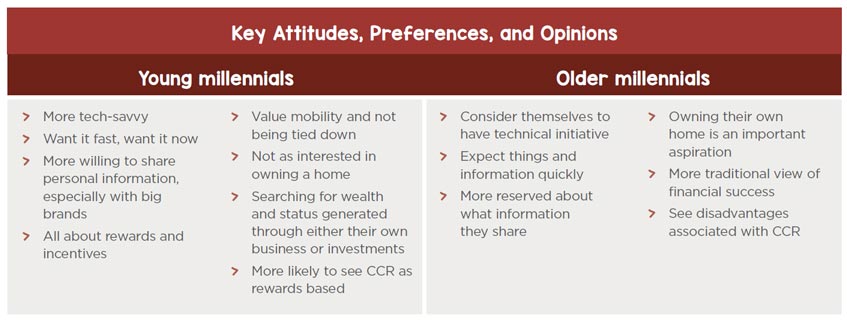Australia’s credit reporting framework has recently undergone a fundamental shift away from a negative only reporting system to comprehensive credit reporting (CCR). Under the changes, lenders can report additional information about borrowers including repayment history such as whether a borrower has paid all credit obligations in a given month, and whether payment was on time, late or missed.
A newly released report examines the knowledge and attitudes of millennials (consumers born between 1980 and mid-2000) towards credit.
It also considers future implications of the shift to CCR in Australia, including the potential use of non-traditional data to assess creditworthiness. Millennials comprise almost a quarter of the population and are the fastest-growing segment of the consumer lending market in Australia. As millennials apply for credit cards, personal loans, car loans and home loans in coming years, lenders will have a range of new tools to assess credit risk and determine millennials’ access to credit.
This research was commissioned by the Customer Owned Banking Association (COBA) and aims to stimulate discussion about the implications of changes to credit reporting for millennials among Australian consumers, policy makers and industry.
This report is based on a three-stage study conducted over a 12 week period, which relied on a primarily qualitative approach. This included: a comprehensive review of domestic and international literature, 15 semistructured interviews across seven key informant groups, and two focus groups with 12 millennials. The findings presented are strictly informed by the literature and the qualitative data collected; they do not reflect the views of Good Shepherd Microfinance.
Despite being the fastest-growing segment for consumer loans, global and domestic research shows that young people are more likely to be ‘thin file’ or ‘credit invisible’ and are overrepresented among financially excluded people. Credit providers rely on previous credit history to make decisions, yet without any prior credit usage, providers have limited to no visibility of the creditworthiness of this group. Their lack of access to mainstream financial products may also make this group vulnerable to predatory lending products.
Our study finds that millennials have a lack of awareness of CCR, hence it will be imperative to raise their awareness to ensure the benefits of CCR are realised. Millennials do not know what data will be collected about them and they have little idea of how their behaviour will impact their creditworthiness now and in the future. Nearly two-thirds of millennials (64%) have never heard of, or do not understand, the term ‘credit report’, according to consumer research commissioned by COBA. Targeted education and transparency of credit assessment decisions will therefore be essential.
This report divides millennials into two distinct groups — the young millennials (18 to 24 years of age) and the older millennials (25 to 35 years of age). The difference between the young and the older millennials lies in their technological capabilities, their attitudes, and the degree to which they are willing to share their personal information digitally. Some millennials — especially young millennials — could more readily see the benefits associated with having a better credit rating as an incentive or reward for ‘good’ credit behaviour. Others had some reservations, seeing the potential for some groups (such as young millennials, those with low incomes, migrants, and early-school leavers) being disadvantaged as they were more likely to be creditinvisible. However, some studies argue that these groups may benefit from the introduction of CCR if payment behaviour from other sources is able to be included in credit-making decisions.
Overseas experience of credit reporting strongly supports the potential for non-traditional or alternative data to complement, rather than substitute, traditional credit data used to assess creditworthiness. Use of this data is particularly relevant for millennials as they generate broad alternative data sets about themselves through their digital behaviours including online payment and social media activity. Using alternative data to determine creditworthiness can open the door to better credit access for many millennials. As a first step, including utility and telecommunications data in credit reporting could facilitate new to credit consumers, such as millennials, to build a credit history without the necessity of borrowing.
More data captured and used by credit providers may mean greater opportunities for millennials and others who are ‘thin file’ or ‘no file’, but it also brings with it risks, particularly for young people who are generally unaware of how this data is captured and used. Potential risks include concerns that over-indebted consumers could be disproportionately impacted; data quality and integrity could lead to inaccurate or misinterpreted credit decisions; privacy and security of personal data; potential use of data for unauthorised purposes e.g. identity theft or fraud; cross-industry differences in data-capture methods and requirements; treatment of hardship or repayment history information; risk-based pricing; as well as a fear of increasing financial or social exclusion resulting from loan defaults. Millennials are a generation that is willing to take control of their personal information and CCR may provide them with an opportunity to do so. However, their lack of awareness and knowledge gaps in relation to credit puts a responsibility on all stakeholders to ensure that these are addressed through targeted education. Having more engaged and responsible consumers also benefits lenders, and can provide a positive flow-on impact on the economy as a whole.

